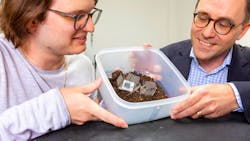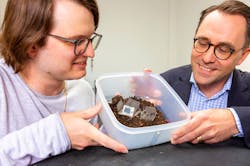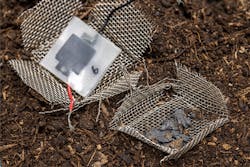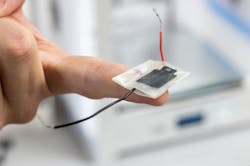The total installed base of Internet of Things (IoT) connected devices worldwide is projected to amount to 30.9 billion units by 2025.
These devices will generate an exponentially increasing amount of electronic waste, pointed out researchers at Empa, the Swiss research institute for applied materials sciences and technology. However, they have invented a capacitor that may help combat the problem.
Capacitors are electrical components that store energy in an electric field. When one is connected to an electrical circuit, a current is discharged. Capacitors vary widely, but the Empa researchers developed a novel version using a modified 3D printer to dispense gelatinous inks onto a surface.
The special formulation consists of cellulose nanofibers and cellulose nanocrystallites, as well as carbon in the form of carbon black, graphite and activated carbon. Glycerin, water and two different types of alcohol are used to liquefy the concoction, note the researchers, along with a pinch of table salt for ionic conductivity.
Four Layers
The process for building the supercapacitor involved 3D printing the four required layers in a continuous stream: a flexible substrate, a conductive layer, the electrode and finally the electrolyte. The layers are folded (“like a sandwich”), with the electrolyte in the center, the researchers said.
The resulting mini-capacitor has the capacity to store electricity for hours and can power a small digital clock, they noted. It is capable of withstanding thousands of charge and discharge cycles and years of storage, even in freezing temperatures, and is resistant to pressure and shock.
Biodegradable Batteries
The invention happens to be good for the environment, too. The capacitor is bio-degradable. The capacitor will have disintegrated within two months, leaving only a few visible carbon particles, said the researchers.
“It sounds quite simple, but it wasn’t at all,” said Xavier Aeby of Empa's Cellulose & Wood Materials lab. An extended series of tests were conducted before settling on reliable working parameters. “As researchers, we don’t want to just fiddle about, we also want to understand what’s happening inside our materials,” said Aeby, who studied microsystems engineering at EPFL and attends Empa for his doctorate.
Aeby worked with his supervisor, Gustav Nyström, to develop the biodegradable electricity storage device. “We applied for Empa internal funding with our project, Printed Paper Batteries, and were able to start our activities with this funding. Now we have achieved our first goal,” said Nyström, who has been investigating functional gels based on nanocellulose for some time. He noted that the material is not only an environmentally friendly, renewable raw material, but has an internal chemistry that makes it extremely versatile.
IoT Applications
The researchers expect the supercapacitor to be a key component for the Internet of Things. For instance, the capacitors could be briefly charged using an electromagnetic field to provide power for a sensor or a microtransmitter for hours. This could be used, for instance, to check the contents of individual packages during shipping. Powering sensors in environmental monitoring or agriculture is also conceivable.
They pointed out that their novel component would also be useful in environments where with the number of electronic microdevices are on the rise. Near-patient laboratory diagnostics or “point of care testing,” are a case in point. Small test devices for use at the bedside or self-testing devices for diabetics are among them. “A disposable cellulose capacitor could also be well suited for these applications,” said Nyström.
About the Author

Rehana Begg
Editor-in-Chief, Machine Design
As Machine Design’s content lead, Rehana Begg is tasked with elevating the voice of the design and multi-disciplinary engineer in the face of digital transformation and engineering innovation. Begg has more than 24 years of editorial experience and has spent the past decade in the trenches of industrial manufacturing, focusing on new technologies, manufacturing innovation and business. Her B2B career has taken her from corporate boardrooms to plant floors and underground mining stopes, covering everything from automation & IIoT, robotics, mechanical design and additive manufacturing to plant operations, maintenance, reliability and continuous improvement. Begg holds an MBA, a Master of Journalism degree, and a BA (Hons.) in Political Science. She is committed to lifelong learning and feeds her passion for innovation in publishing, transparent science and clear communication by attending relevant conferences and seminars/workshops.
Follow Rehana Begg via the following social media handles:
X: @rehanabegg
LinkedIn: @rehanabegg and @MachineDesign



